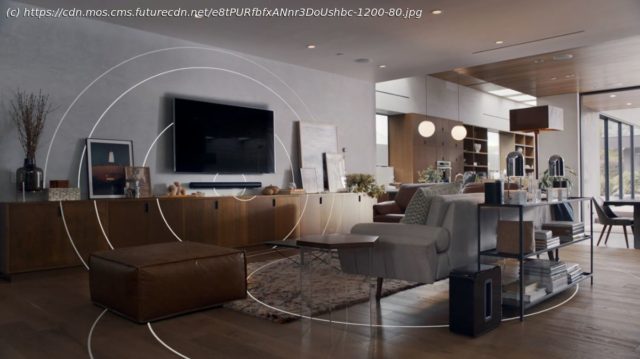Spatial audio is the biggest speaker upgrade since surround sound. Here’s your field guide to the biggest formats and how to get them.
Immersive sound formats are taking the world of home audio by storm, with Apple’s Spatial Audio joining the likes of Dolby Atmos, DTS:X, Sony’s 360 Reality Audio and Creative’s Super SXFI in the quest to make 3D sound in the home more accessible than ever. Though these audio technologies differ in the way they enable immersive sound, they are all capable of making the sound of your music, films, and games feel as though it’s coming from all around you. Whether you call it immersive,3D, or spatial audio, these technologies are the biggest thing to happen to home cinema and music listening since surround sound. While surround sound gave our music a sense of horizontal direction, spatial audio takes this one step further by adding height cues to film soundtracks and music. Imagine the difference between hearing a helicopter flying a few hundred yards away versus directly over your head, and you’re nearly there. For cinephiles, spatial audio makes films feel more engrossing, placing you right in the action, and it allows gamers to hear the sound of enemy footsteps creeping towards them from any direction. More recently, spatial audio has been expanded to music too, with some formats placing instruments in a virtual sphere so you can feel as though you’re surrounded by the musicians in your favorite bands, or sitting in the midst of a full orchestra. Exciting right? While the world of spatial audio is definitely a step forward for cinephiles, gamers, and music lovers, it can also be pretty confusing, with lots of different formats to choose from. Where you can find support for these formats also varies, with each TV and music streaming service offering support for one format exclusively, a mixture of a few, or none at all. And, once you’ve worked out where you can get spatial audio content, you need to make sure you have the right equipment to experience it, whether that’s a Dolby Atmos soundbar, a DTS:X-touting AV receiver, or a pair of Apple AirPods Pro true wireless earbuds. To help cut down on the confusion, we’ve put together this handy guide to the top spatial audio formats you can try right now, as well as everything you need to take your content to the glorious third dimension. Dolby Atmos is probably the best-known of all the spatial audio formats, having been originally developed for cinema and later making its way to the world of music streaming. The format gives sound a more three-dimensional effect than traditional surround formats, with sound designers taking elements from a track and placing them in a virtual sphere. This allows movie makers to make sounds feel as though they are coming at you from all angles, which is particularly useful for cinema. For example, a helicopter flying overhead in a film could be made to sound as though it’s really flying above you with the help of Dolby Atmos. ‘True’ Dolby Atmos makes use of overhead speakers to achieve this effect, though innovations in the world of soundbars and speakers has made it possible for home cinema enthusiasts to experience the format for themselves. These days you can get soundbars with upfiring tweeters that bounce sound up to your ceiling and back down to your ears or add-on modules that allow your existing speakers to deliver Dolby Atmos when combined with a compatible AV receiver. However, if you don’t have upfiring tweeters or overhead speakers, you can still experience Dolby Atmos with the company’s Height Virtualization technology, which makes use of your existing 5.1,7.1, or stereo speaker setup. It essentially works by tricking your brain into thinking certain sounds are originating from above you, using height cue filters that simulate the natural cues imparted by the human ear to sounds arriving from overhead. Dolby Atmos is also available for music, placing individual instruments and effects within that virtual sphere instead of elements from a movie soundtrack. The format can be applied to new music or as part of a remaster, provided the original audio stems are available to edit. When you play the music back, it should feel as though you’re enveloped in a dome of sound, and it works with speakers or via Dolby Atmos for Headphones. DTS:X is very similar to Dolby Atmos in that it creates three-dimensional sound that moves around you as it would in real life. The big difference however, is that DTS:X doesn’t require overhead speakers or upfiring tweeters, working with standard surround sound speaker setups up to a maximum 11.2-channel system. You can use overhead channels if you want to create a more convincing 3D sound experience, though. DTS:X also has the added benefit of allowing you to manually adjust different sound elements, so you could increase the volume of dialogue on a soundtrack if you’re struggling to hear them over loud music or effects. Apple’ Spatial Audio is the company’s answer to Dolby Atmos for Headphones, designed for the AirPods Pro true wireless earbuds and AirPods Max over-ear headphones. It takes 5.1,7.1, and Dolby Atmos content and applies directional audio filters, placing sound in a 3D sphere. What’s unique to Spatial Audio though, is that it uses the built-in accelerometers and gyroscopes inside Apple’s earbuds and headphones to track the position of your head, as well as the position of your iPhone or iPad.
Home
United States
USA — software Spatial Audio: Your complete guide to immersive speakers, headphones, and streaming services






